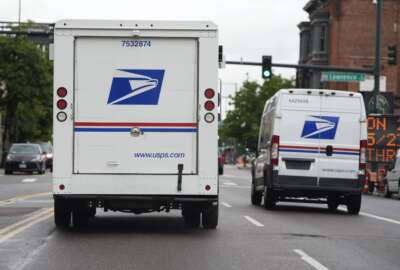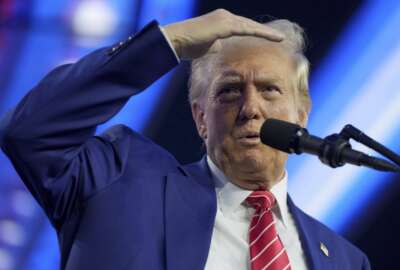DOGE-supporting lawmakers call on USPS to privatize some operations, scrap electric fleet
The Congressional DOGE Caucus plans to take a closer look at USPS operations, and identify ways to make the agency more efficient.
The Postal Service isn’t meeting its break-even goals under a 10-year reform plan. But House Republicans are drafting their own efficiency proposals for the agency.
GOP members of the House Oversight and Accountability Committee are pushing back on USPS plans to purchase mostly electric vehicles in the coming years, and some are calling on the incoming Trump administration’s Department of Government Efficiency (DOGE) to find additional ways for the agency to cut costs.
Committee Chairman James Comer (R-Ky.) applauded Postmaster General Louis DeJoy for coming up with the 10-year Delivering for America plan, but said the agency is “hemorrhaging red ink.”
“I appreciate the fact that you have a plan, and you’re trying to implement that plan. That’s what we want with DOGE. That’s what the American people want with DOGE,” Comer said.
USPS saw a $9.5 billion net loss in fiscal 2024, and is pursuing cost-cutting initiatives that received bipartisan pushback from the Senate Homeland Security and Governmental Affairs Committee last week.
“This year’s loss was almost $10 billion. Next year’s loss is projected to be $6.5 billion. And with each loss comes an explanation of how much it was out of your control,” Comer told DeJoy.
Among his recommendations, Comer suggested USPS privatize its mail processing operations. Tens of thousands of USPS employees represented by the National Postal Mail Handlers Union and the American Postal Workers Union work in mail processing facilities nationwide.
“There are private companies that are interested, which is where I think a lot of the problems are,” Comer said.
Comer, however, stopped short of endorsing any plan to privatize the entire agency. The Trump administration considered privatizing USPS as part of a 2018 government reorganization plan.
“When we talk about efficiency, especially members on this side of the aisle, we think of privatization, and you’ll have people say, ‘We should privatize the Post Office.’ The problem with that is nobody wants to deliver the mail to every house in America six days a week, and to operate all those retail postal facilities. There’s no private company in the world that wants that,” Comer said.
Comer also questioned why USPS under DeJoy’s tenure converted 190,000 pre-career employees into career positions, with better pay and benefits. Comer said the agency’s personnel and retirement expenses are “huge liabilities.”
“There are things Mr. DeJoy Is trying to do in-house that would be better left to the private sector,” Comer said. “This isn’t going to work unless we look for ways to do more with fewer people. I think the theme of this new administration is going to be how to make government more efficient.”
Rep. Marjorie Taylor Greene (R-Ga.), chairwoman on a new DOGE subcommittee in the next session of Congress, wrote on X (formerly Twitter) that “the Postal Service is supposed to break even, but poor management is costing taxpayers billions.”
“This is a prime example of what DOGE and my Delivering on Government Efficiency committee will work to fix,” Greene wrote.
USPS is generally self-funded, but received $10 billion in emergency appropriations in 2020 to offset losses at the height of the COVID-19 pandemic. Lawmakers also gave USPS more than $3 billion in the Inflation Reduction Act to buy more electric vehicles and chargers than it could afford on its own.
Rather than privatize operations, USPS under DeJoy has begun insourcing some of the trucking and logistics work it previously outsourced to private contractors.
However, DeJoy told Comer he would keep an open mind to feedback from the new Congress and the Trump administration.
“I will work with you to understand what it is that you want us to consider. And I will work very hard to either identify that we could do it, or to say that it’s just not going to work for us,” DeJoy said.
USPS, under DeJoy’s 10-year reform plan, predicted it would “break even” by fiscal 2023 or 2024, and reverse a chain of annual net losses that date back to the 2008 recession.
DeJoy, however, said USPS is falling short of those goals because of rising inflation and the agency paying more than its share into a federal retirement fund that some postal retirees qualify for.
USPS has more retirees than current employees. DeJoy told lawmakers USPS will have about 600,000 employees next year, and about 720,000 retirees.
“That’s a problem,” he said.
In a “Delivering for America 2.0” plan released in October, USPS asked Congress to raise its current $15 billion borrowing limit with the Treasury Department. It also called on the Office of Personnel Management to reassess what it pays into the Civil Service Retirement System, the pension system for federal employees who began government service before 1987.
DeJoy, however, said the new plan doesn’t include an updated break-even goal, because it requires some actions from Congress and the White House.
“This is why we did not put a forecast in for when the break-even was, because it’s not something we can do ourselves,” he said.
“I have a date and time and a projection, but if I say that, that becomes the whole discussion —what we didn’t get accomplished, not what we got accomplished. So I’m a little wiser being here in Washington for 4 years now,” DeJoy added.
Government Operations Subcommittee Chairman Pete Sessions (R-Texas), one of three co-chairmen of the Congressional DOGE Caucus, called on DeJoy to designate a point of contact at USPS to work with the new caucus.
The DOGE Caucus, which covers both the House and Senate, will support the Trump administration’s Department of Government Efficiency, an advisory council outside the federal government led by billionaire businessmen Elon Musk and Vivek Ramaswamy.
“I have found in the past, not to be critical, that the Post Office does not always place its highest priority of saving money,” Sessions told DeJoy. “I have had several conversations where we have referred potential savings, and I’m not sure that we heard an answer back. You’re going to get ready to see these things come publicly.”
Sessions told Federal News Network that the DOGE Caucus intends to take a closer look at USPS operations, and identify ways to make the agency more efficient.
“Government efficiency is important. Workforce, personnel issues are important, and money is important,” Sessions said. “I told [DeJoy] that I would want him, in essence, to put a point of contact, that we could run these ideas by, instead of a rather bureaucratic response system that today does not give us back answers.”
Among its areas of focus, Sessions said lawmakers in support of DOGE are skeptical of the Postal Service’s plans for a majority-electric next-generation delivery vehicle fleet.
“If you just look at the fleets that people have, cars on an individual basis, they’re thought to be wildly more expensive. Not only to keep up with, but the lifecycle is different,” Sessions said.
Republican members of the committee spent much of the three-hour hearing scrutinizing the agency’s plans for electric vehicles.
According to Reuters, President-elect Donald Trump is considering unwinding the Postal Service’s electric vehicles contracts, as part of an upcoming executive order.
“I want him to be able to respond back from a business model and give us answers. He is not struggling on this question. He’s probably had five questions about EVs, but the answers are not readily available, and they need to be, because in a new world, where we go into DOGE, as one of its vice chairmen, I will give these questions to them and expect an answer,” Sessions said.
DeJoy said he would not have invested in electric vehicles “as aggressively and deliberately as we had,” if USPS didn’t receive $3 billion in funding from Congress.
Before Congress passed the legislation, DeJoy said USPS would make electric vehicles 10% of its next-generation delivery vehicle fleet. The Biden administration criticized those plans, and USPS faced several federal lawsuits over plans to purchase a mostly gasoline-powered fleet.
“I was in the crossfire of a whole bunch of issues, and did not agree to put electric vehicles into our fleet until we had the appropriate cost benefits to the organization,” DeJoy said.
USPS is spending about $10 billion of its own money on a new fleet of more than 100,000 custom-built and commercial vehicles. About 66,000 of them will be electric vehicles.
“I feel good where we are,” DeJoy said. “We couldn’t put electric vehicles everywhere and we couldn’t put electric vehicles in overnight. But once installed, and you offset the capital cost, which we have, it’s a pretty decent thing. It’s a nice vehicle.”
USPS expects its custom-built Next-Generation Delivery Vehicles will run for about 20-25 years. DeJoy said some of the agency’s electric vehicles can run for about three days on a single charge, and that he is looking at ways to “expand the ratio between the vehicles and the chargers.”
DeJoy said USPS will see lower maintenance costs with EVs, and would save on fuel costs. But he said it remains unclear what kind of return on investment USPS will see over the total lifecycle of its electric vehicles.
“Let’s say a battery lasts 10 years. There is a cost-benefit to us on maintenance and fuel and so forth for the 10 years. It is when you go to buy that new battery, using today’s battery cost, that it could put us over the return,” he said.
Most USPS delivery routes cover about 15-20 miles.
Regardless of what’s under the hood of these new vehicles, DeJoy says USPS is in urgent need of a new fleet. Many of the iconic Grumman Long Life Vehicles USPS is phasing out are 30 years old, and lack modern features like airbags, air conditioning and backup cameras.
“The Congress gave us $3 billion, and we’re using it wisely,” DeJoy said. “I wouldn’t have done it unless we thought it was financially viable and good for the service. We needed vehicles. This was the way we were able to move forward, and I think we worked a good strategy, with regard to this.”
Republican lawmakers, however, remain wary of USPS moving forward with its electric fleet.
“I worry about that EV money sitting around, that it may be clawed back,” Comer said. “I think there are lots of areas where there’s going to be significant reform over the next four years.”
Copyright © 2025 Federal News Network. All rights reserved. This website is not intended for users located within the European Economic Area.
Jory Heckman is a reporter at Federal News Network covering U.S. Postal Service, IRS, big data and technology issues.
Follow @jheckmanWFED






